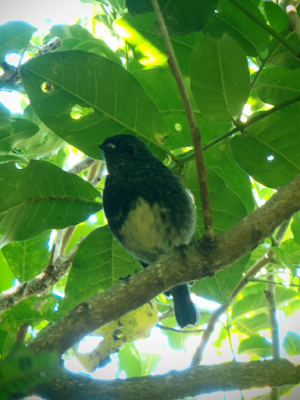Porphyrio hochstetteri
IUCN Redlist: Endangered
Location: Tiritiri Matangi Island, New Zealand
Time: 1200 NZDT March 9, 2012
The takahe are without doubt the stars of Tiritiri Matangi. They are also famous for having returned from (presumed) extinction after 50 years of absence. Takahe are the largest living rail, and are flightless. They evolved from
pukeko, or a pukeko-like ancestor, which presumably flew to New Zealand from Australia. Another species, the North Island Takahe, or Moho, may have survived until the late 19th Century, but is only known from subfossil remains. The takahe, moho and pukeko all represent independent colonisation events.
Reappearing Act
Takahe formerly ranged across the South Island, but after European settlement were known from only 4 specimens, collected in 1849, 1851, 1879 and 1898. After the turn of the century takahe were presumed to be extinct. Geoffrey Orbell, however, believed that the takahe survived somewhere in the depths of Fiordland, and spent a lot of time searching for it. In 1948 he was searching among the mountains on the western side of Lake Te Anau, and found a set of unfamiliar footprints. Following them, he rediscovered the takahe on the 20th of November, 50 years after the last specimen was collected.
The takahe had been squeezed by introduced species into a refuge high in the Murchison Mountains. Mainly eating the tender base of tussock grasses, takahe were facing competition from deer, as well as predation by species like stoats. Soon after their rediscovery their habitat in the Murchison Mountains was set aside as the Takahe Special Area, and efforts at captive breeding began in 1957, but their population continued to decline, reaching a nadir of 118 animals in 1981. The effort to protect takahe was intensified, including control of pest species, captive breeding and introduction to predator-free sanctuaries. Today takahe live in two areas in Fiordland, four islands, the Burwood Bush Captive Rearing Unit, and Maungatautari Ecological Island (a fenced, predator-free sanctuary). A few individuals used for outreach and advocacy are also kept at the Mt. Bruce and Te Anau Wildlife Centres, as well as at Zealandia Sanctuary in Wellington.
 |
Juvenile takahe on Tiritiri Matangi
|
The total population was estimated at 227 birds in 2008, with 93 in the Murchison Mountains, 91 on islands and 36 at Burwood Bush. In addition takahe sightings are occasionally reported from areas of Fiordland outside the Murchison Mountains, but it is too rugged to attempt to find them all.
 |
Takahe (right) and pukeko (left) feeding on grass near the lighthouse on Tiritiri Matangi
|
The population on Tiritiri Matangi is about 10 birds, and is believed to be at carrying capacity. The island populations are managed as a single population, with birds moved between islands to maintain genetic diversity. One bird on Tiri, called Greg, has developed a taste for human food, and has become very confident, attempting to take food from people's hands, and stealing from bags. I'm sure there are other examples, but it's not common for such a rare bird to be in a sanctuary that is open to the public like Tiritiri Matangi is, so it always feels like quite a privilege to visit.
Though the takahe, being flightless, might be considered "captive" on Tiritiri Matangi, I'm counting them since they are breeding there - and since all takahe are intensively managed, even the Fiordland populations aren't exactly much different from these ones, you're just not allowed to enter their habitat without a permit.
References
Wickes, C.; Crouchley, D.; Maxwell, J. 2009: Takahe (Porphyrio hochstetteri) recovery plan 2007–2012. Threatened Species Recovery Plan 61. Department of Conservation, Wellington. 56 p.


















































